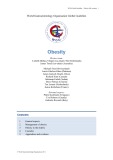
Management of obesity
-
Document "Obesity" presentation of content: General aspects, management of obesity, obesity in the elderly, cascades, stakeholders and management options, management options relative to available resources, pharmacotherapy, lifestyle changes, surgery, obesity and the elderly.
 49p
49p  vovanvovan2013
vovanvovan2013
 13-05-2016
13-05-2016
 34
34
 1
1
 Download
Download
-
The three restrictive-malabsorptive bypass procedures combine the elements of gastric restriction and selective malabsorption. These procedures include Roux-en-Y gastric bypass (RYGB), biliopancreatic diversion (BPD), and biliopancreatic diversion with duodenal switch (BPDDS) (Fig. 75-2). RYGB is the most commonly performed and accepted bypass procedure. It may be performed with an open incision or laparoscopically.
 5p
5p  konheokonmummim
konheokonmummim
 03-12-2010
03-12-2010
 78
78
 6
6
 Download
Download
-
Peripherally Acting Medications Orlistat (Xenical) is a synthetic hydrogenated derivative of a naturally occurring lipase inhibitor, lipostatin, produced by the mold Streptomyces toxytricini. Orlistat is a potent, slowly reversible inhibitor of pancreatic, gastric, and carboxylester lipases and phospholipase A2, which are required for the hydrolysis of dietary fat into fatty acids and monoacylglycerols. The drug acts in the lumen of the stomach and small intestine by forming a covalent bond with the active site of these lipases.
 7p
7p  konheokonmummim
konheokonmummim
 03-12-2010
03-12-2010
 84
84
 8
8
 Download
Download
-
Physical Activity Therapy Although exercise alone is only moderately effective for weight loss, the combination of dietary modification and exercise is the most effective behavioral approach for the treatment of obesity. The most important role of exercise appears to be in the maintenance of the weight loss. Currently, the minimum public health recommendation for physical activity is 30 min of moderate intensity physical activity on most, and preferably all, days of the week.
 5p
5p  konheokonmummim
konheokonmummim
 03-12-2010
03-12-2010
 99
99
 5
5
 Download
Download
-
Lifestyle Management Obesity care involves attention to three essential elements of lifestyle: dietary habits, physical activity, and behavior modification. Because obesity is fundamentally a disease of energy imbalance, all patients must learn how and when energy is consumed (diet), how and when energy is expended (physical activity), and how to incorporate this information into their daily life (behavior therapy). Lifestyle management has been shown to result in a modest (typically 3– 5 kg) weight loss compared to no treatment or usual care.
 5p
5p  konheokonmummim
konheokonmummim
 03-12-2010
03-12-2010
 85
85
 7
7
 Download
Download
-
Assessing the Patient's Readiness to Change An attempt to initiate lifestyle changes when the patient is not ready usually leads to frustration and may hamper future weight-loss efforts. Assessment includes patient motivation and support, stressful life events, psychiatric status, time availability and constraints, and appropriateness of goals and expectations. Readiness can be viewed as the balance of two opposing forces: (1) motivation, or the patient's desire to change; and (2) resistance, or the patient's resistance to change.
 5p
5p  konheokonmummim
konheokonmummim
 03-12-2010
03-12-2010
 75
75
 6
6
 Download
Download
-
Excess abdominal fat, assessed by measurement of waist circumference or waist-to-hip ratio, is independently associated with higher risk for diabetes mellitus and cardiovascular disease. Measurement of the waist circumference is a surrogate for visceral adipose tissue and should be performed in the horizontal plane above the iliac crest. Cut points that define higher risk for men and women based on ethnicity have been proposed by the International Diabetes Federation (Table 75-3).
 7p
7p  konheokonmummim
konheokonmummim
 03-12-2010
03-12-2010
 85
85
 7
7
 Download
Download
-
Harrison's Internal Medicine Chapter 75. Evaluation and Management of Obesity Evaluation and Management of Obesity: Introduction Over 66% of U.S. adults are currently categorized as overweight or obese, and the prevalence of obesity is increasing rapidly throughout most of the industrialized world. Based on statistics from the World Health Organization, overweight and obesity may soon replace more traditional public health concerns such as undernutrition and infectious diseases as the most significant contributors to ill health.
 12p
12p  konheokonmummim
konheokonmummim
 03-12-2010
03-12-2010
 94
94
 9
9
 Download
Download
-
Diabetes mellitus affects 1-2% of many national populations. Its successful management requires close collaboration between the patient and the doctor.
 20p
20p  bigbaby87
bigbaby87
 03-09-2010
03-09-2010
 95
95
 15
15
 Download
Download
CHỦ ĐỀ BẠN MUỐN TÌM





















